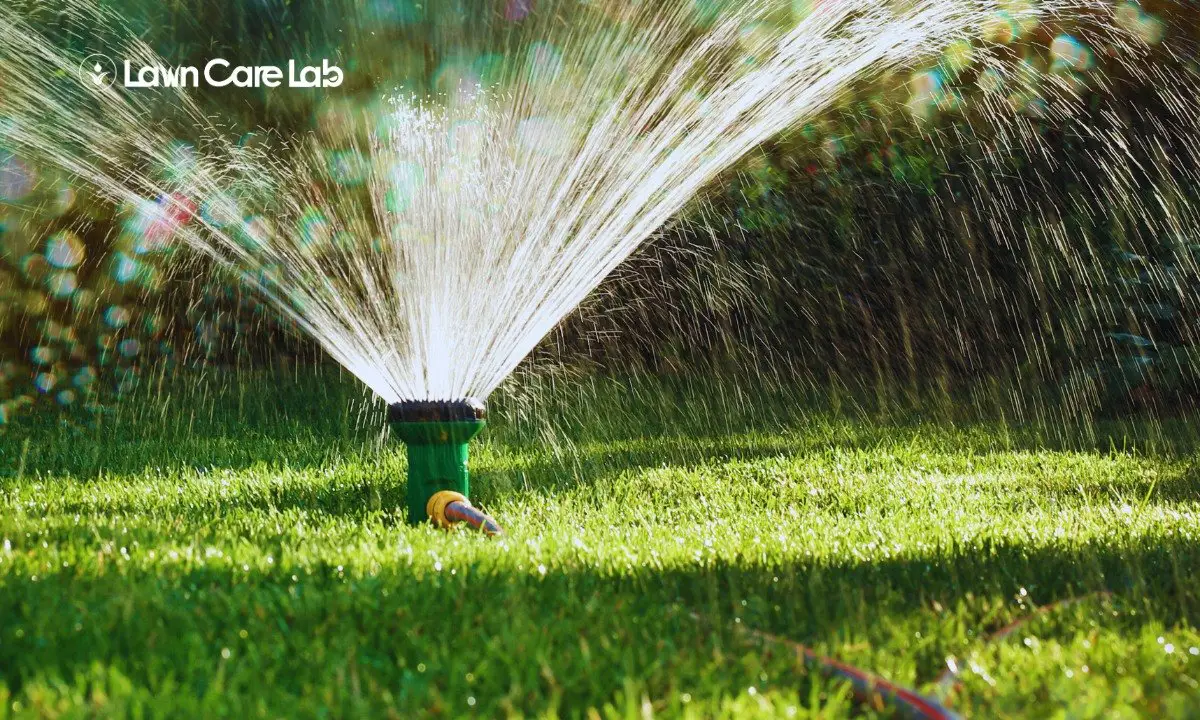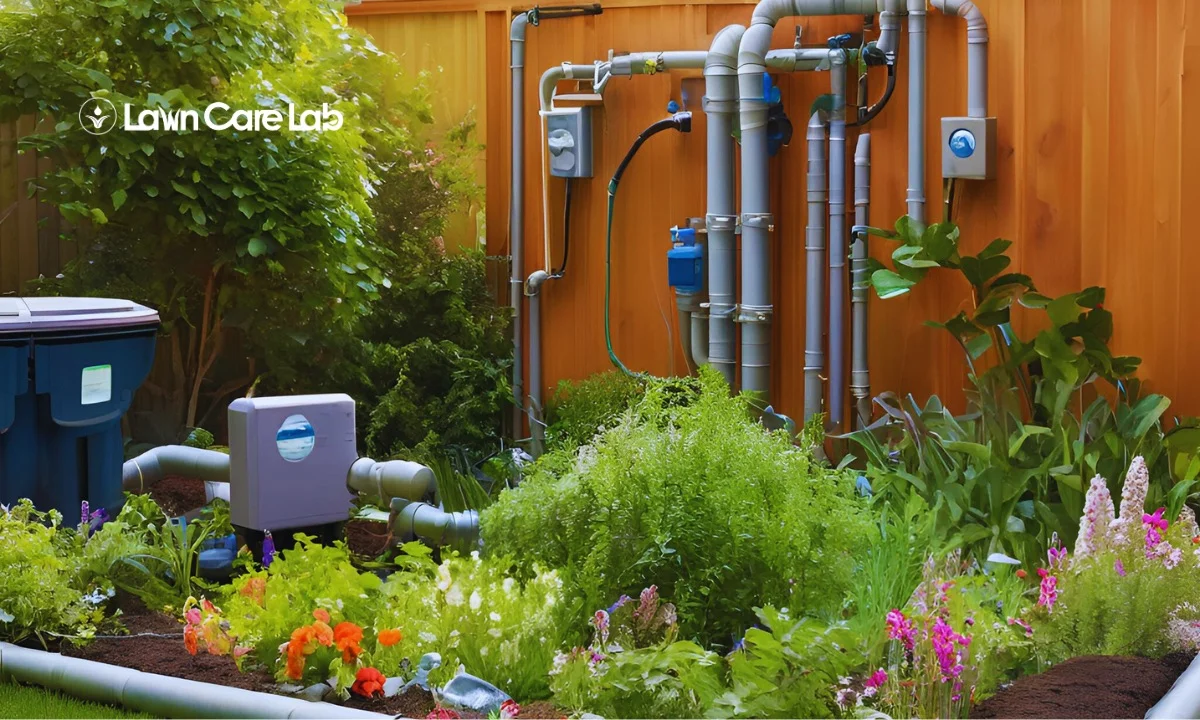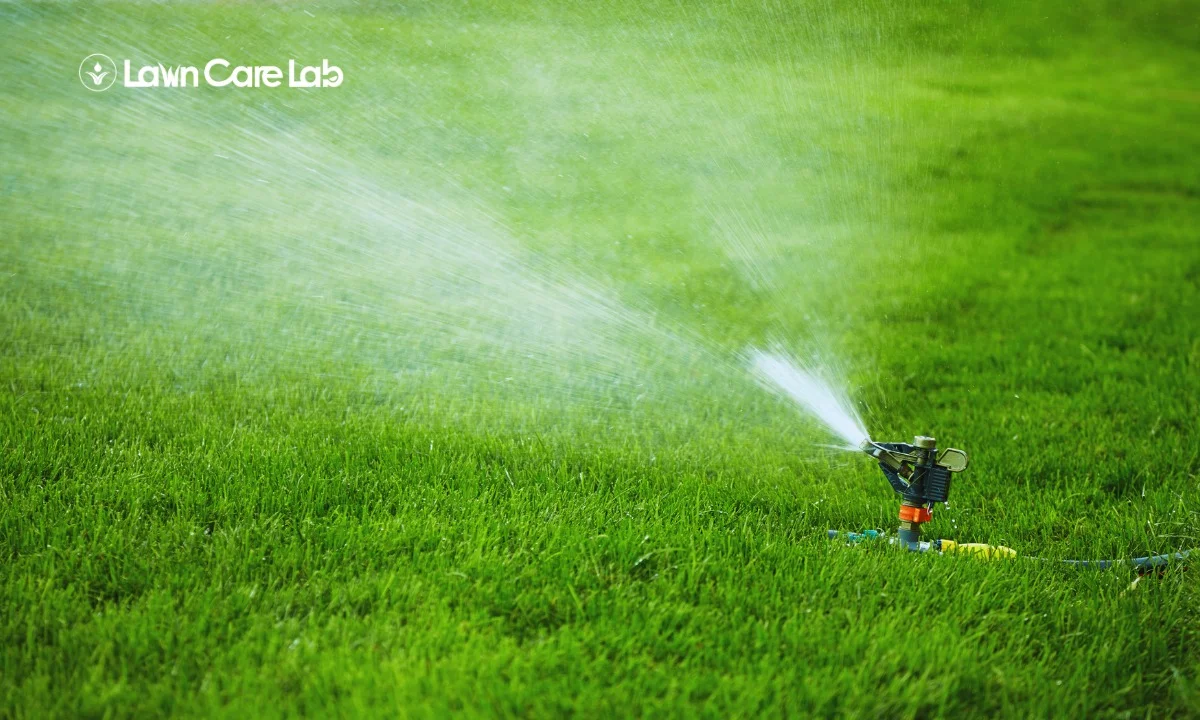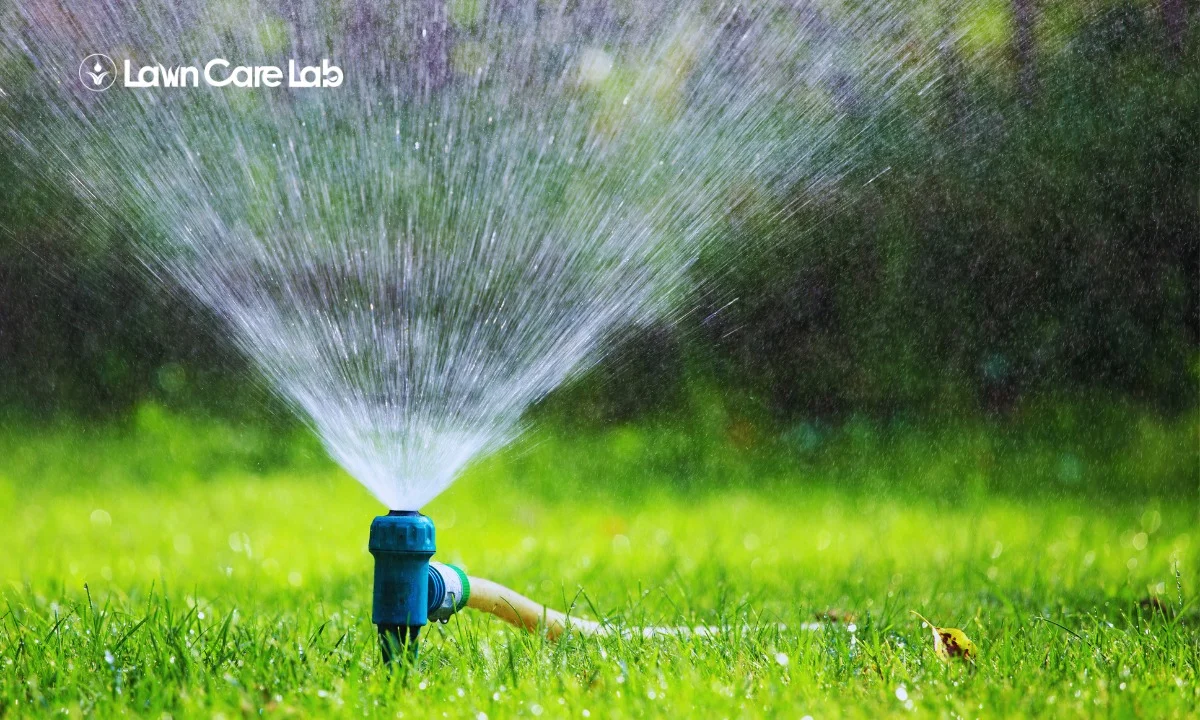Ever dreamt of maintaining a lush, vibrant lawn throughout the scorching summer? Struggling with those pesky shaded spots? You’re not the only one.
We’re here with some clever shady watering tips. Armed with the right sprinklers, nozzles, and techniques, you’re on your way to transforming your lawn into a green haven.
Let’s make your gardening dreams come true.
Table of Contents
Why Shady Areas Need Special Hydration
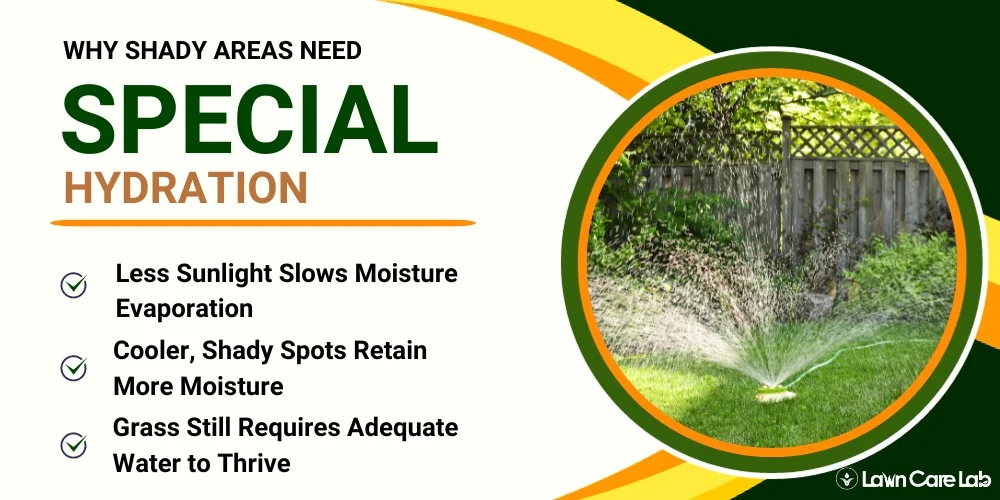
Shaded areas in your yard need extra care. These spots retain moisture for longer periods due to lower heat and sunlight levels, making it important to take care of them.
Your lawn needs enough water for deep root growth and nutrient absorption to stay healthy and green.
Less Sunlight Slows Moisture Evaporation
Less sunlight in shady lawn areas slows down moisture evaporation, affecting watering frequency and methods.
Here are a few handy tips to keep the green spaces of your garden thriving while saving water:
- Water less often. Check soil moisture before watering shaded areas.
- Try to water either early morning or late evening to prevent the water from evaporating too quickly in the direct sun.
- Consider getting an efficient irrigation system to distribute water evenly throughout your lawn.
- Drip irrigation delivers water directly to plant roots for efficient hydration.
Cooler, Shady Spots Retain More Moisture
Shaded parts of your garden need tailored watering due to their higher moisture retention. Adjust watering methods based on the differences in soil moisture between sunny and shaded spots.
Here’s a guide:
- Ferns thrive with drip irrigation.
- Hostas prefer soaker hoses.
- Hydrangeas do well with sprinkler systems.
- Rhododendrons benefit from rainwater harvesting.
- Azaleas require manual watering.
Watering subtleties can improve the drought-resistance of shade-loving plants for a healthy garden, but remember to water shaded grass adequately.
Grass Still Requires Adequate Water to Thrive
Shaded areas of your lawn need hydration, too. Overwatering or not watering enough can hurt your lawn. Find a balance for healthy grass growth.
Watch for waterlogging, root rot, or drought stress. Adjust watering frequency and monitor drainage if unsure.
Use mulch in these areas to retain moisture and provide a nutritional boost to the soil.
Shady Watering Tips: Best Practices for Shaded Lawns

For a thriving, vibrant, shaded lawn, there are a few watering tips you might want to implement.
You could start by hydrating your lawn early in the morning, which ensures the soil soaks up the water before the heat of the day can cause evaporation.
Another good strategy is to water deeply but not too often to encourage root growth.
Lastly, you may want to think about using a drip irrigation system, especially under trees, to provide targeted hydration.
Water Early for Better Moisture Absorption
Water your shaded lawn early in the morning with deep watering to make it lush and vibrant.
Mulching improves soil moisture absorption, encourages root growth, and reduces water evaporation. It also keeps your lawn cool and refreshed.
What’s more? Your lawn gets a cool, refreshing start before the day heats up and stays cleaner since it’s watered before dust can gather.
Aim for Deep, Infrequent Watering
Deep and infrequent watering is key for a healthy, green lawn. It encourages strong roots and improves water retention.
Water thoroughly every few days to help roots grow deeper and make your turf more resilient. Adjust your routine if you notice browning or wilting grass.
This approach ensures a lush, green lawn throughout the season.
Consider Drip Irrigation Under Trees
Use drip irrigation for shaded areas in your yard. It saves water and promotes soil moisture and root growth.
Benefits include improved soil hydration, stimulated growth, and reduced water evaporation/runoff.
So, don’t underestimate this creative solution for maintaining a healthy, vibrant, shaded lawn.
Now, let’s discuss how to choose the best sprinklers and nozzles for your yard.
Choosing the Right Sprinklers and Nozzles
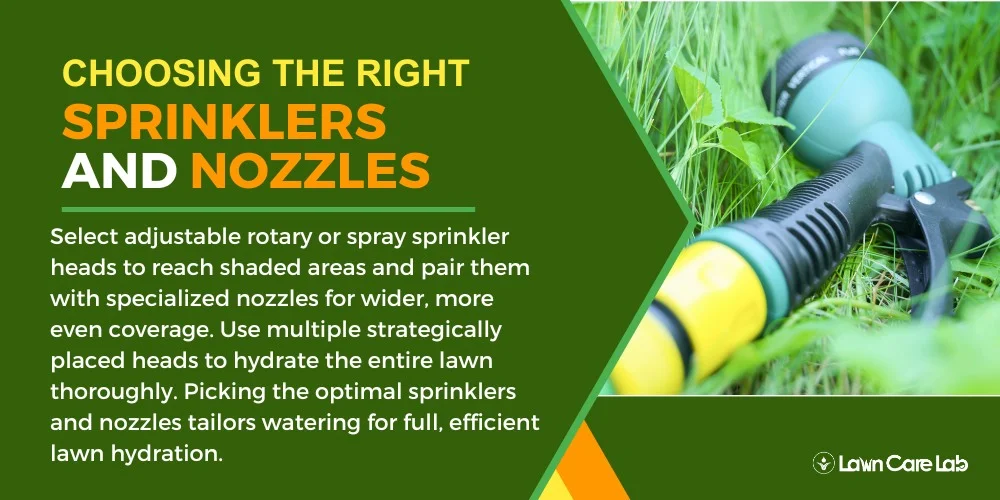
Picking the right sprinklers and nozzles can make a world of difference when trying to keep your lawn lush, especially in shady spots.
Rotary sprinklers or spray heads are your best bet, and adjustable nozzles boost their reach.
Use Rotary or Spray Sprinkler Heads
Spray and rotary heads are efficient watering options for your lawn, with cool features that promote even watering and lush green growth.
Picking the right sprinkler head can make a world of difference in maintaining a consistently green lawn.
Adjust Nozzles for Wider Coverage
Adjusting your sprinkler nozzles can improve lawn coverage, especially in cooler, shaded corners. Small tweaks to the adjustable features can significantly increase sprinkler efficiency.
Cover hard-to-reach areas easily with a wider spray pattern. Fine-tune your setup to keep your entire lawn hydrated and thriving.
Use Multiple Heads for Full Lawn Coverage
Use multiple sprinkler heads for even watering and a vibrant green lawn.
Choose adjustable sprinklers and shaded area nozzles for better control.
Proper placement of the sprinklers is crucial to take full advantage of these advanced watering techniques.
Signs Your Shady Lawn Needs More Hydration

Pay attention to your lawn’s signals for water, including drooping, wilted grass, brown or yellow leaves, and sparse growth.
Increase your watering activities if you hear a crunch when you step on the grass or notice less fresh growth.
Droopy, Wilted Grass Blades
Limp grass in shady areas means you need to water more, especially for shade-loving grasses.
Here’s what you can do:
First, tweak your watering schedule to ensure your lawn receives adequate hydration without promoting fungal growth.
Next, Consider mulching to hold in soil moisture, especially during droughts.
By implementing these simple and creative lawn care strategies, your grass blades will stand tall in no time.
Up next, we’ll chat about another key hydration sign – browning or yellowing leaves.
Brown or Yellowing Leaves
Brown or yellow leaves on a shady lawn suggest a lack of hydration and nutrients.
To revive the lawn, increase watering frequency to distribute nutrients and keep it healthy.
Crunchy Grass When Walked On
Check for dry grass and brown leaves, which indicate your lawn needs more water. Detecting dehydration early is vital for a healthy and lush lawn.
Here’s a couple of tips to get you started:
- For better results, increase watering frequency in the early morning or late evening to avoid evaporation.
- Keep an eye on the weather to adjust your schedule accordingly.
- Deep watering promotes strong roots and saves water by reducing runoff.
- Consistency and timing are key to keeping your lawn looking its best.
Less New Growth and Thinner Grass
To keep your lawn vibrant, it’s important to monitor the water levels, soil dampness, and shadow endurance of your grass.
Here’s a cheat sheet for you:
- Fescue needs moderate watering and is highly shade-tolerant.
- Bermuda requires more frequent watering and isn’t as shade-tolerant.
- Zoysia has similar needs as Fescue, while Centipede needs less water and has moderate shade tolerance.
- St. Augustine likes a lot of water and can handle the shade pretty well.
Keep track of these factors to tweak your watering habits and enjoy a verdant lawn, even in the most shaded areas.
Conclusion
You’ve got the knowledge to maintain that cool, green lawn.
Don’t forget an unexpected half of the water for irrigation gets wasted through evaporation or runoff from excessive watering.
Stick to these guidelines, and you won’t just have a garden that’s the talk of the town, but you’ll also be making a green choice.
Here’s to a more sustainable, greener lawn!
Frequently Asked Questions
What Type of Grass Is Best for Shady Areas?
How Often Should I Fertilize My Shady Lawn?
Are There Specific Types of Sprinklers That Are Not Suitable for Shady Lawns?
What Type of Lawn Diseases Should I Watch Out for on My Shady Lawn?
How Can I Prevent My Lawn From Getting Too Much Shade?
- How to Create a Lawn Care Schedule for Southern Climates - October 30, 2024
- How to Use Compost Tea to Boost Lawn Growth and Soil Health - October 23, 2024
- The Best Grasses for Saltwater-Exposed Lawns: Coastal Lawn Care - October 17, 2024

